2015 NISSAN XTERRA 4WD
[x] Cancel search: 4WDPage 357 of 396
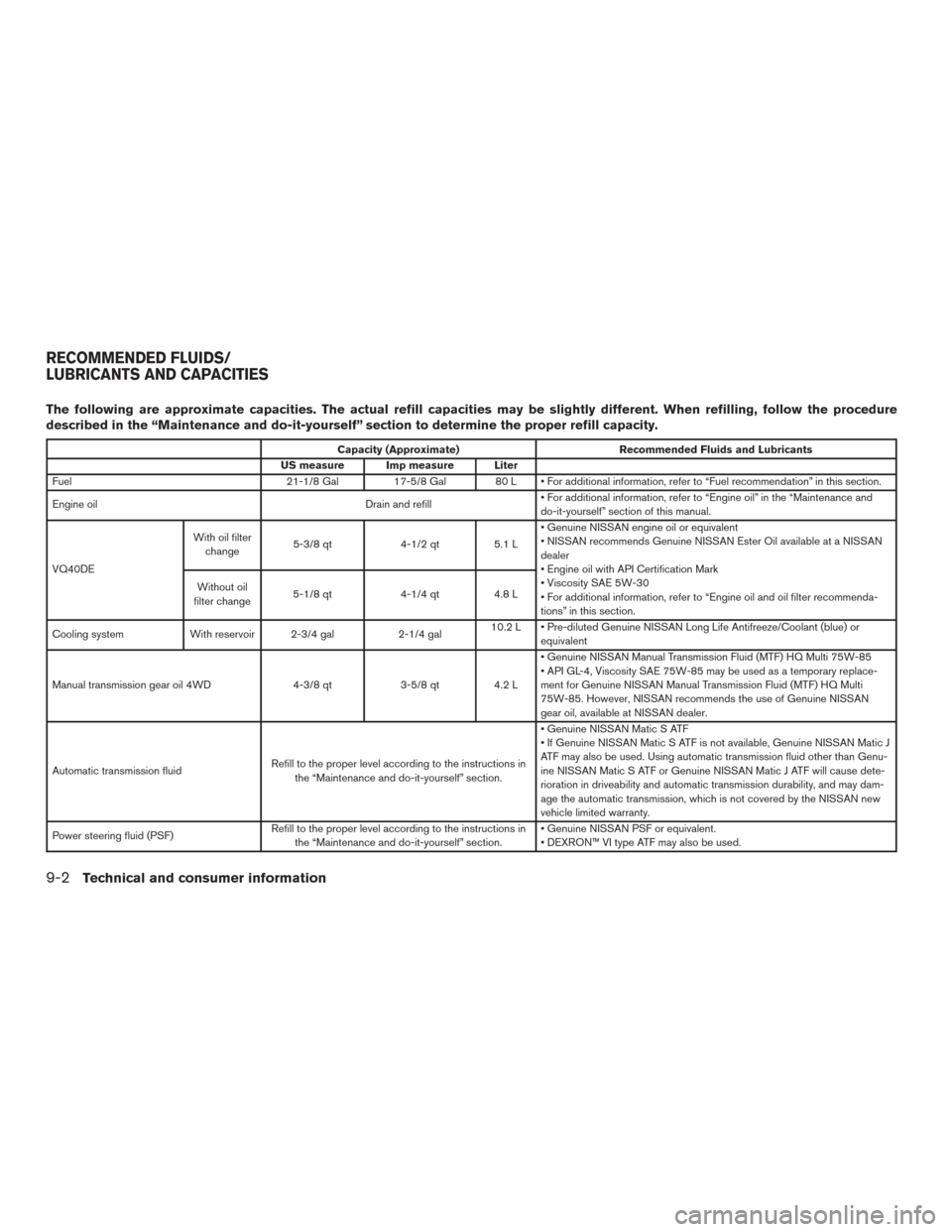
The following are approximate capacities. The actual refill capacities may be slightly different. When refilling, follow the procedure
described in the “Maintenance and do-it-yourself” section to determine the proper refill capacity.
Capacity (Approximate)Recommended Fluids and Lubricants
US measure Imp measure Liter
Fuel 21-1/8 Gal17-5/8 Gal 80 L • For additional information, refer to “Fuel recommendation” in this section.
Engine oil Drain and refill• For additional information, refer to “Engine oil” in the “Maintenance and
do-it-yourself” section of this manual.
VQ40DE With oil filter
change 5-3/8 qt
4-1/2 qt5.1 L• Genuine NISSAN engine oil or equivalent
• NISSAN recommends Genuine NISSAN Ester Oil available at a NISSAN
dealer
• Engine oil with API Certification Mark
• Viscosity SAE 5W-30
• For additional information, refer to “Engine oil and oil filter recommenda-
tions” in this section.
Without oil
filter change 5-1/8 qt
4-1/4 qt4.8 L
Cooling system With reservoir 2-3/4 gal 2-1/4 gal10.2 L • Pre-diluted Genuine NISSAN Long Life Antifreeze/Coolant (blue) or
equivalent
Manual transmission gear oil 4WD 4-3/8 qt3-5/8 qt4.2 L• Genuine NISSAN Manual Transmission Fluid (MTF) HQ Multi 75W-85
• API GL-4, Viscosity SAE 75W-85 may be used as a temporary replace-
ment for Genuine NISSAN Manual Transmission Fluid (MTF) HQ Multi
75W-85. However, NISSAN recommends the use of Genuine NISSAN
gear oil, available at NISSAN dealer.
Automatic transmission fluid Refill to the proper level according to the instructions in
the “Maintenance and do-it-yourself” section. • Genuine NISSAN Matic S ATF
• If Genuine NISSAN Matic S ATF is not available, Genuine NISSAN Matic J
ATF may also be used. Using automatic transmission fluid other than Genu-
ine NISSAN Matic S ATF or Genuine NISSAN Matic J ATF will cause dete-
rioration in driveability and automatic transmission durability, and may dam-
age the automatic transmission, which is not covered by the NISSAN new
vehicle limited warranty.
Power steering fluid (PSF) Refill to the proper level according to the instructions in
the “Maintenance and do-it-yourself” section. • Genuine NISSAN PSF or equivalent.
• DEXRON™ VI type ATF may also be used.
RECOMMENDED FLUIDS/
LUBRICANTS AND CAPACITIES
9-2Technical and consumer information
Page 381 of 396
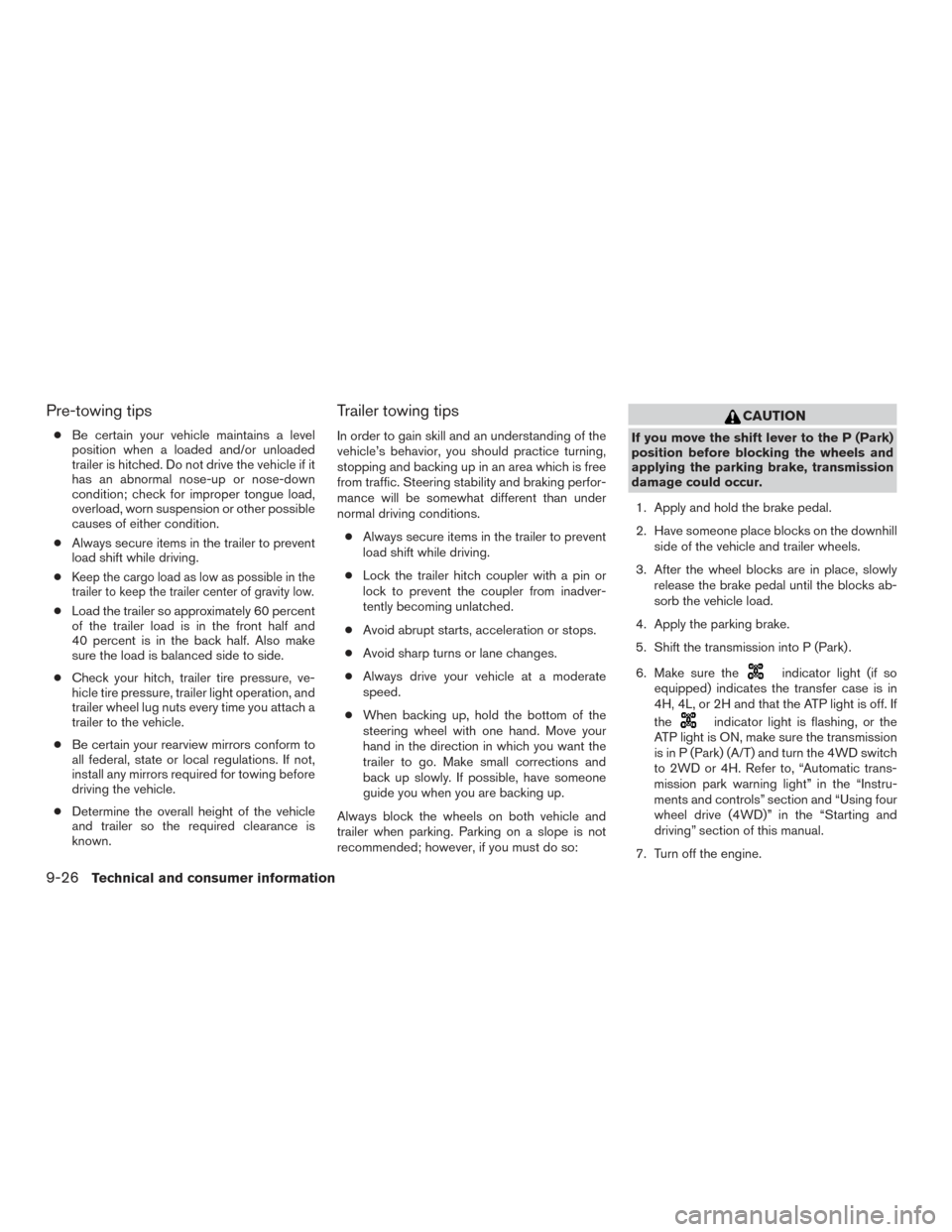
Pre-towing tips
●Be certain your vehicle maintains a level
position when a loaded and/or unloaded
trailer is hitched. Do not drive the vehicle if it
has an abnormal nose-up or nose-down
condition; check for improper tongue load,
overload, worn suspension or other possible
causes of either condition.
● Always secure items in the trailer to prevent
load shift while driving.
●
Keep the cargo load as low as possible in the
trailer to keep the trailer center of gravity low.
● Load the trailer so approximately 60 percent
of the trailer load is in the front half and
40 percent is in the back half. Also make
sure the load is balanced side to side.
● Check your hitch, trailer tire pressure, ve-
hicle tire pressure, trailer light operation, and
trailer wheel lug nuts every time you attach a
trailer to the vehicle.
● Be certain your rearview mirrors conform to
all federal, state or local regulations. If not,
install any mirrors required for towing before
driving the vehicle.
● Determine the overall height of the vehicle
and trailer so the required clearance is
known.
Trailer towing tips
In order to gain skill and an understanding of the
vehicle’s behavior, you should practice turning,
stopping and backing up in an area which is free
from traffic. Steering stability and braking perfor-
mance will be somewhat different than under
normal driving conditions.
● Always secure items in the trailer to prevent
load shift while driving.
● Lock the trailer hitch coupler with a pin or
lock to prevent the coupler from inadver-
tently becoming unlatched.
● Avoid abrupt starts, acceleration or stops.
● Avoid sharp turns or lane changes.
● Always drive your vehicle at a moderate
speed.
● When backing up, hold the bottom of the
steering wheel with one hand. Move your
hand in the direction in which you want the
trailer to go. Make small corrections and
back up slowly. If possible, have someone
guide you when you are backing up.
Always block the wheels on both vehicle and
trailer when parking. Parking on a slope is not
recommended; however, if you must do so:
CAUTION
If you move the shift lever to the P (Park)
position before blocking the wheels and
applying the parking brake, transmission
damage could occur.
1. Apply and hold the brake pedal.
2. Have someone place blocks on the downhill side of the vehicle and trailer wheels.
3. After the wheel blocks are in place, slowly release the brake pedal until the blocks ab-
sorb the vehicle load.
4. Apply the parking brake.
5. Shift the transmission into P (Park) .
6. Make sure the
indicator light (if so
equipped) indicates the transfer case is in
4H, 4L, or 2H and that the ATP light is off. If
the
indicator light is flashing, or the
ATP light is ON, make sure the transmission
is in P (Park) (A/T) and turn the 4WD switch
to 2WD or 4H. Refer to, “Automatic trans-
mission park warning light” in the “Instru-
ments and controls” section and “Using four
wheel drive (4WD)” in the “Starting and
driving” section of this manual.
7. Turn off the engine.
9-26Technical and consumer information
Page 386 of 396
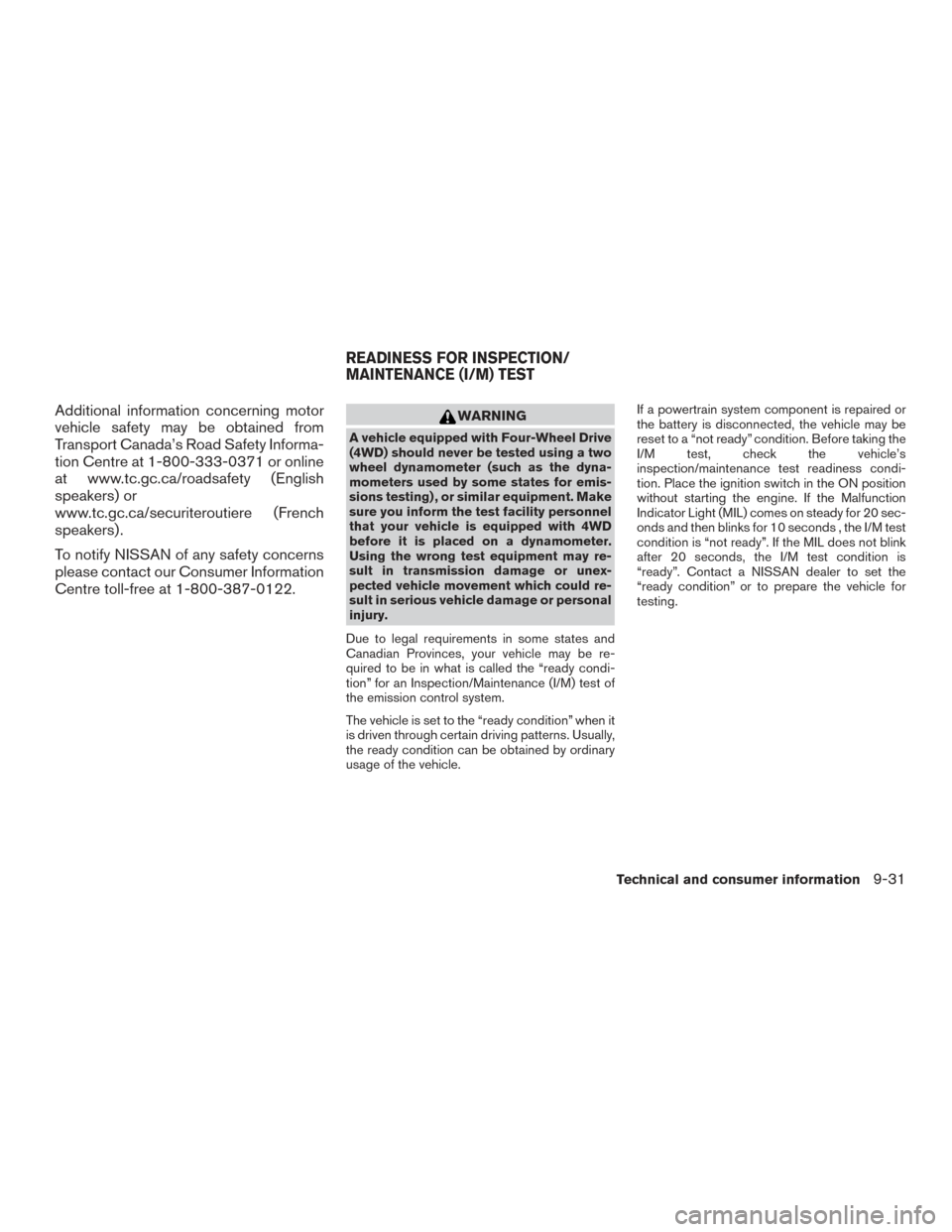
Additional information concerning motor
vehicle safety may be obtained from
Transport Canada’s Road Safety Informa-
tion Centre at 1-800-333-0371 or online
at www.tc.gc.ca/roadsafety (English
speakers) or
www.tc.gc.ca/securiteroutiere (French
speakers) .
To notify NISSAN of any safety concerns
please contact our Consumer Information
Centre toll-free at 1-800-387-0122.WARNING
A vehicle equipped with Four-Wheel Drive
(4WD) should never be tested using a two
wheel dynamometer (such as the dyna-
mometers used by some states for emis-
sions testing) , or similar equipment. Make
sure you inform the test facility personnel
that your vehicle is equipped with 4WD
before it is placed on a dynamometer.
Using the wrong test equipment may re-
sult in transmission damage or unex-
pected vehicle movement which could re-
sult in serious vehicle damage or personal
injury.
Due to legal requirements in some states and
Canadian Provinces, your vehicle may be re-
quired to be in what is called the “ready condi-
tion” for an Inspection/Maintenance (I/M) test of
the emission control system.
The vehicle is set to the “ready condition” when it
is driven through certain driving patterns. Usually,
the ready condition can be obtained by ordinary
usage of the vehicle. If a powertrain system component is repaired or
the battery is disconnected, the vehicle may be
reset to a “not ready” condition. Before taking the
I/M test, check the vehicle’s
inspection/maintenance test readiness condi-
tion. Place the ignition switch in the ON position
without starting the engine. If the Malfunction
Indicator Light (MIL) comes on steady for 20 sec-
onds and then blinks for 10 seconds , the I/M test
condition is “not ready”. If the MIL does not blink
after 20 seconds, the I/M test condition is
“ready”. Contact a NISSAN dealer to set the
“ready condition” or to prepare the vehicle for
testing.
READINESS FOR INSPECTION/
MAINTENANCE (I/M) TEST
Technical and consumer information9-31
Page 388 of 396
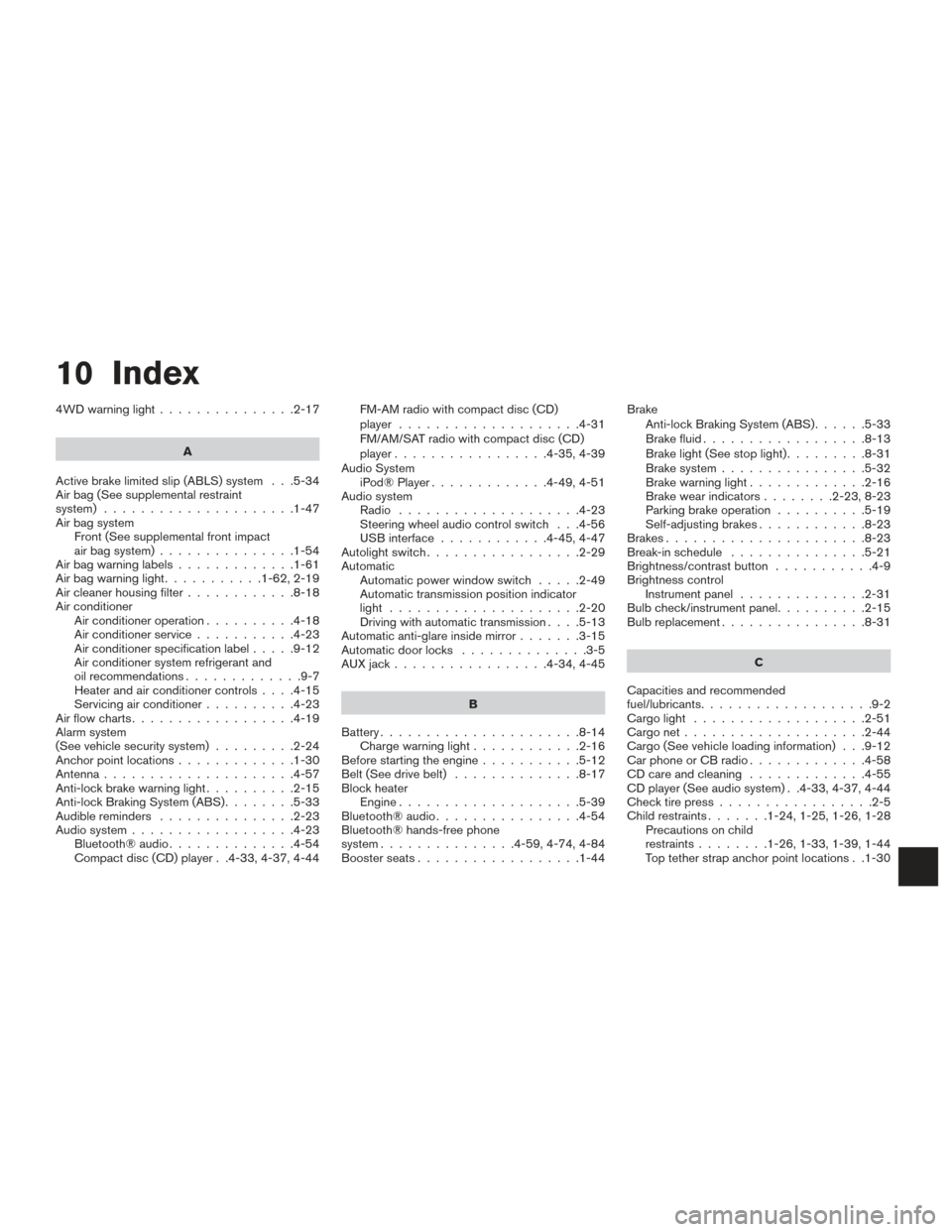
10 Index
4WDwarninglight...............2-17A
Active brake limited slip (ABLS) system . . .5-34
Air bag (See supplemental restraint
system) .....................1-47
Air bag system Front (See supplemental front impact
air bag system) ...............1-54
Airbagwarninglabels.............1-61
Airbagwarninglight...........1-62,2-19
Air cleaner housing filter ............8-18
Air conditioner Air conditioner operation ..........4-18
Air conditioner service ...........4-23
Air conditioner specification label .....9-12
Air conditioner system refrigerant and
oil recommendations .............9-7
Heater and air conditioner controls ....4-15
Servicing air conditioner ..........4-23
Airflowcharts..................4-19
Alarm system
(See vehicle security system) .........2-24
Anchor point locations .............1-30
Antenna .....................4-57
Anti-lock brake warning light ..........2-15
Anti-lock Braking System (ABS) ........5-33
Audible reminders ...............2-23
Audio system ..................4-23
Bluetooth®audio..............4-54
Compact disc (CD) player . .4-33, 4-37, 4-44 FM-AM radio with compact disc (CD)
player ....................4-31
FM/AM/SAT radio with compact disc (CD)
player.................4-35,4-39
Audio System iPod® Player .............4-49,4-51
Audio system Radio ....................4-23
Steering wheel audio control switch . . .4-56
USB interface ............4-45,4-47
Autolight switch .................2-29
Automatic Automatic power window switch .....2-49
Automatic transmission position indicator
light .....................2-20
Driving with automatic transmission ....5-13
Automatic anti-glare inside mirror .......3-15
Automatic door locks ..............3-5
AUXjack.................4-34,4-45
B
Battery ......................8-14
Chargewarninglight............2-16
Before starting the engine ...........5-12
Belt (See drive belt) ..............8-17
Block heater Engine ....................5-39
Bluetooth®audio................4-54
Bluetooth® hands-free phone
system ...............4-59,4-74,4-84
Boosterseats..................1-44 Brake
Anti-lock Braking System (ABS) ......5-33
Brake fluid ..................8-13
Brakelight(Seestoplight).........8-31
Brake system ................5-32
Brakewarninglight.............2-16
Brakewearindicators........2-23,8-23
Parking brake operation ..........5-19
Self-adjusting brakes ............8-23
Brakes ......................8-23
Break-inschedule ...............5-21
Brightness/contrast button ...........4-9
Brightness control Instrument panel ..............2-31
Bulb check/instrument panel ..........2-15
Bulbreplacement................8-31
C
Capacities and recommended
fuel/lubricants ...................9-2
Cargolight ...................2-51
Cargonet....................2-44
Cargo (See vehicle loading information) . . .9-12
Car phone or CB radio .............4-58
CDcareandcleaning .............4-55
CD player (See audio system) . .4-33, 4-37, 4-44
Check tire press .................2-5
Child restraints .......1-24,1-25,1-26,1-28
Precautions
on child
restraints ........1-26,1-33,1-39,1-44
Top tether strap anchor point locations . .1-30
Page 393 of 396
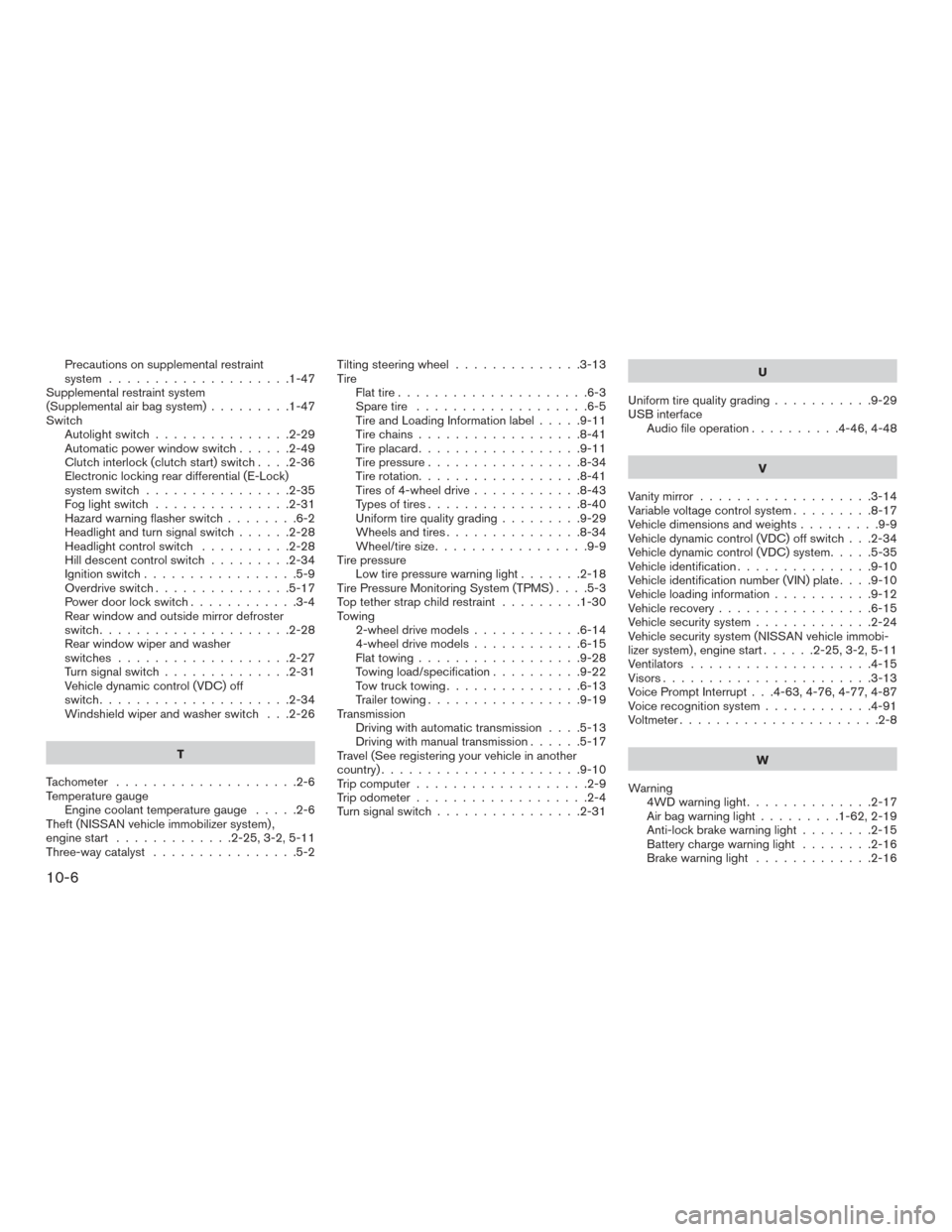
Precautions on supplemental restraint
system ....................1-47
Supplemental restraint system
(Supplemental air bag system) .........1-47
Switch Autolightswitch...............2-29
Automatic power window switch ......2-49
Clutch interlock (clutch start) switch ....2-36
Electronic locking rear differential (E-Lock)
systemswitch................2-35
Foglightswitch ...............2-31
Hazard warning flasher switch ........6-2
Headlight and turn signal switch ......2-28
Headlight control switch ..........2-28
Hill descent control switch .........2-34
Ignition switch .................5-9
Overdrive switch ...............5-17
Power door lock switch ............3-4
Rear window and outside mirror defroster
switch.....................2-28
Rear window wiper and washer
switches ...................2-27
Turnsignalswitch..............2-31
Vehicle dynamic control (VDC) off
switch.....................2-34
Windshield wiper and washer switch . . .2-26
T
Tachometer ....................2-6
Temperature gauge Engine coolant temperature gauge .....2-6
Theft (NISSAN vehicle immobilizer system) ,
engine start .............2-25,3-2,5-11
Three-way catalyst ................5-2 Tilting steering wheel
..............3-13
Tire Flat tire .....................6-3
Spare tire ...................6-5
Tire and Loading Information label .....9-11
Tirechains..................8-41
Tireplacard..................9-11
Tire pressure .................8-34
Tirerotation..................8-41
Tires of 4-wheel drive ............8-43
Types of tires .................8-40
Uniform tire quality grading .........9-29
Wheels and tires ...............8-34
Wheel/tire size .................9-9
Tire pressure Low tire pressure warning light .......2-18
Tire Pressure Monitoring System (TPMS) ....5-3
Top tether strap child restraint .........1-30
Towing 2-wheel drive models ............6-14
4-wheel drive models ............6-15
Flattowing..................9-28
Towing load/specification ..........9-22
Towtrucktowing...............6-13
Trailer towing .................9-19
Transmission Driving with automatic transmission ....5-13
Driving with manual transmission ......5-17
Travel (See registering your vehicle in another
country) ......................9-10
Trip computer ...................2-9
Trip odometer ...................2-4
Turn signal switch ................2-31 U
Uniform tire quality grading ...........9-29
USB interface Audio file operation ..........4-46,4-48
V
Vanity mirror ...................3-14
Variable voltage control system .........8-17
Vehicle dimensions and weights .........9-9
Vehicle dynamic control (VDC) off switch . . .2-34
Vehicle dynamic control (VDC) system .....5-35
V
ehicle identification ...............9-10
Vehicle identification number (VIN) plate ....9-10
Vehicle loading information ...........9-12
Vehicle recovery .................6-15
Vehicle security system .............2-24
Vehicle security system (NISSAN vehicle immobi-
lizer system) , engine start ......2-25,3-2,5-11
Ventilators ....................4-15
Visors.......................3-13
Voice Prompt Interrupt . . .4-63, 4-76, 4-77, 4-87
Voice recognition system ............4-91
Voltmeter ......................2-8
W
Warning 4WDwarninglight..............2-17
Air bag warning light .........1-62,2-19
Anti-lock brake warning light ........2-15
Battery charge warning light ........2-16
Brake warning light .............2-16
10-6